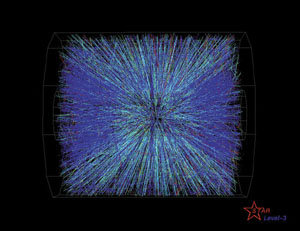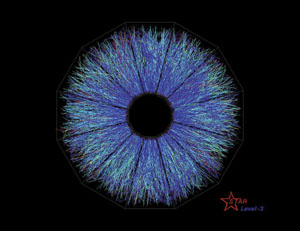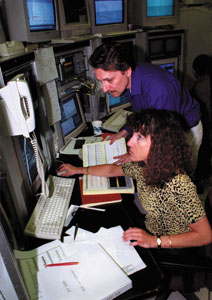

After achieving first collisions of gold ion beams on the night of 12 June, the gleaming new Relativistic Heavy Ion Collider (RHIC) facility at Brookhaven wasted no time in ramping up in energy and intensity and starting the process of analysing data.
A few days after the first gold ions collided at a collision energy of 56 GeV/nucleon, all four of the RHIC detectors (BRAHMS, PHENIX, PHOBOS and STAR) began recording data at a collision energy of 130 GeV/nucleon. By the end of July the first physics result – a measurement of charged particle density at mid-rapidity for central gold -gold collisions at these two energies – was submitted for publication by the PHOBOS collaboration.


With these data points in hand, and further analysis results in the pipeline from each of the four experiments, theorists who were at Brookhaven to attend a series of summer workshops immediately began to ponder the first glimpse of high-density matter in this new energy regime.
In the meantime the machine staff shifted focus from first collisions to achieving sustained collider operation. The goal for machine operation over the summer was to bring the collider and its injector complex, consisting of tandem Van de Graaff, booster and AGS synchrotron, to the level at which all of the experiments would obtain an initial data run with event rates approaching 10% of the final design luminosity.

By mid-August, RHIC’s two superconducting rings were routinely colliding stored beams of gold ions, with the full complement of 55 ion bunches in each ring, beam lifetimes of more than 4 h and some storage cycles lasting 10 h and more. The four experiments simultaneously recorded data throughout these runs, transferring data to the RHIC Computing Facility at peak rates of more than 40 Mbyte/s.
RHIC ran through mid-September, with continued data taking as well as accelerator physics work to complete the commissioning of the collider systems. A comprehensive look at the first physics results from this year’s run will take place at the Quark Matter 2001 meeting on 15-20 January, which is being jointly hosted by the State University of New York at Stony Brook and Brookhaven. It is expected that the collider will start up again early in 2001 and begin operating soon after at the full design energy of 200 GeV/nucleon for gold-gold collisions.







